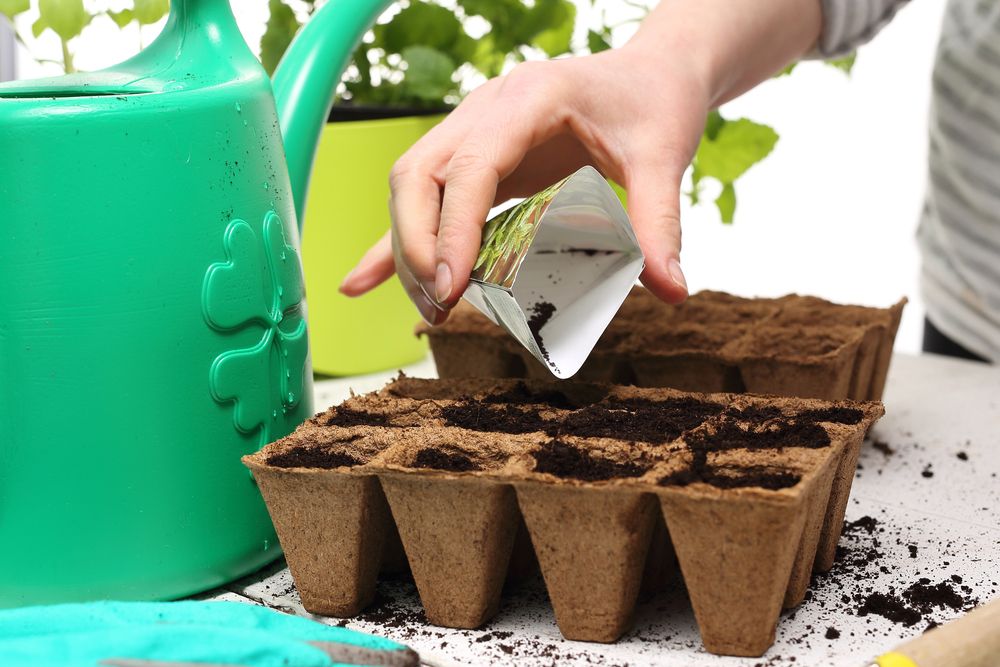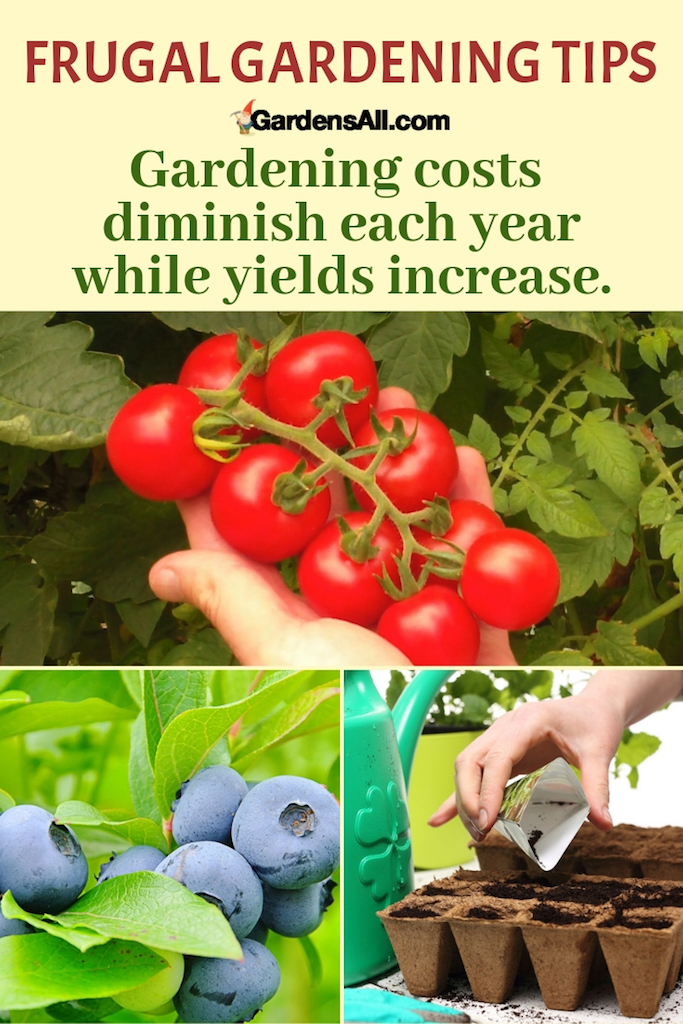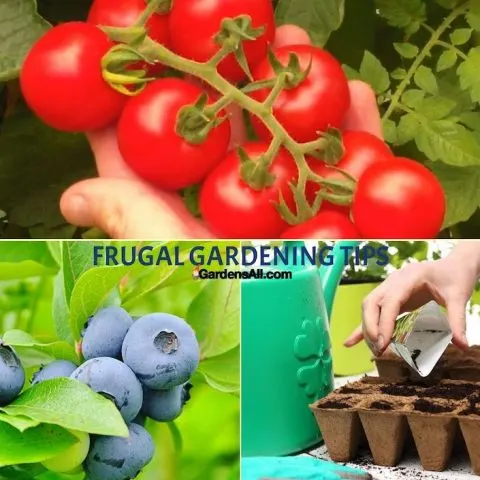Get more for less with a little planning.
As entrepreneurs and business owners, we’re always considering the value of our time and the return on investment ROI of our endeavors. So frugal gardening is an important part of our planting planning.
A conversation with our plumber when we were having our well pump replaced, got our attention as the inspiration for this article on frugal gardening tips.
“It cost us more to grow our tomatoes than if I would’ve bought a few bushels to can from the Farmer’s Market.” David, our plumber said as he was replacing our well pump.
Beginner Gardening Costs, Frustrations and Mistakes
David was discouraged that they had put so much time and money into growing tomatoes, only to end up with a disappointing yield. We didn’t want to interrupt his work to get into all the details of what they did or didn’t do for their tomato crop that might’ve made a difference, though we wanted to.
However, we totally understand the frustration.
Common Beginner Mistakes
- Forgetting to plan for all the extra infrastructure costs to starting a garden
- Not properly planning for garden space based on:
- plant size needs
- companion planting
- length of growing season of each plant
- infrequent watering
- not assessing garden soil needs
- giving up at the first sign of problems. (DON’T GIVE UP)!
- not keeping an eye on plant problems
Beginning Gardener’s – Costs to Get Started
Beginning gardeners often get discouraged when they realize that gardening is not as simple as planting seeds and ending up with an abundance of fruits and vegetables. Gardening definitely takes work—and money, especially in the beginning when you have to invest in the the infrastructure.
The most important first step in planting a garden is to begin with healthy garden soil. Toward that, you’ll want to know what your soil needs. If your soil is lacking important nutrients, it will need amendments and fertilizers. So either you pay for a soil test and wait for the results, or you can just ask your yard!
Your weeds can inform you as to the nature of your soil health. what will grow best in the soil that you have.
Frugal Gardening Tip:
Your weeds are the language of the soil and provide a free soil health test to inform you about the makeup of your soil.
~GardensAll.com
Gardening Supplies You May Need to Start Gardening
Many of These Are Free Things You May Have On Hand
- Containers – such as:
- grow bags
- plant trays for starting seeds
- plant covers – save containers that can be made into plant covers, mini greenhouses, and/or drip irrigation, such as:
- milk jugs
- salad clamshells
- spring water jugs
- Fertilizers – make cheap or free compost tea by growing comfrey
- Compost – make your own
- Soil / Growing medium – if you need garden soil, check with a local feed and seed mill store. A dump truck load will save money over bags of soil if you have a place for it.
- Soil amendments – make and use organic compost and natural mulch such as:
- leaves, grass clippings and most all other organic clippings and refuse
- non-meat kitchen scraps, including –
- eggshells good for calcium
- coffee grounds
- tea bags
- all other organic produce scraps, including banana peels, but not avocado seeds (unless pulverized)
- Gardening tools – good gardening tool maintenance will helps yours last
- Grow lights – starting plants indoors can save you time and allow you to grow more and harvest sooner
- Heating mats for starting seed packets
- Hoses – we use drip irrigation but hoses will do for newbies
- Mulch – including how to get free wood chips
- cardboard and recycled paper
- straw mulch, organic
- wood chip mulch
- Plants – seedlings and starts aren’t free but they can save time, so that you can grow more
- Seeds – to saving seeds, and seed swaps (check online groups and local gardening or social groups)
- Soil tester
- Row covers
More Cost Now, Less Cost Later
Don’t let this seemingly long list deter you. Everything new is hard at first, and the costs are more in the beginning before dwindling down to virtually zero cost gardening. But there are ways to set up your garden to take less time and less money. And the good news, is that with some simple frugal gardening strategies, gardening costs diminish each year while yields increase.
With simple frugal gardening strategies, gardening costs diminish each year while yields increase.
~GardensAll.com
Zero Cost Gardening is Real
When we first shared this article on the Gardens All Facebook page, several folks commented that they’re already doing this. So $0 gardening is a real thing that’s already working for them and many. Yay!!
Zero cost gardening is possible. But first, let’s learn more from some seasoned pros! We’ve posted some of those comments at the end of this article to inspire and encourage you.
We enjoyed reading this article from blogger, master gardener and landscape artist, Claire Jones. Claire has done it all and shares the best tips from her 30 years of gardening experience.
So let’s get into it!
Starting Seeds for Frugal Gardening
Starting seeds will save you some money if you do it right. For instance, some plants are a waste to buy because they’re easy and inexpensive to grow from seeds.
Some plants are a waste to buy. Direct seed these.
Direct Sow Vegetable Seeds
- Cucumber
- Corn
- Beans
- Melons
- Squash
- Lettuce
- Herbs
Direct seed these when the soil warms up.
Direct Sow Flowers
- Zinnias
- Poppies
- Cosmos
- Sunflowers
- Marigolds
- Tithonia
These flowers grow easily from seed and it would be throwing money away to buy plants of these as plants cost a lot more than the seeds! Direct seeded plants will also typically outperform transplants as they are already rooted in.
Usually, the larger the seed the easier to germinate.
~Claire Jones on TheGardenDiaries.Wordpress.com

Best Vegetables to Grow and Why
First, Grow the Foods You Most Enjoy
It may sound obvious, but sometimes (okay… often!), we can be lured into deciding what to grow by the enticing glossy seed catalogs. We were.
We ended up with lots of sorrel and rhubarb, neither of which we’d ever made use of before!! That’s not altogether a bad thing because it’s great to try new things, and we enjoy doing that. It’s just that we have limited sunlit garden space, so it’s far better to make the most use of every inch of space by growing things we eat the most (or would if we had regular access to it).
Growing your favorites begins with making a list of all the produce you regularly buy from your local grocer or farmers market. whatever produce you’re spending money on, if you can grow that, you’ll not only have the best and freshest version of that from your garden, you’ll also not be spending as much money on it.
So consider first, what fresh foods your family likes and eats the most. Of those, choose first to grow things that are pricey at the market, but relatively easy to grow.
Find more on how to decide what vegetables to grow here.
More Expensive Foods That Are Easy to Grow
- VEGETABLES:
- Artichokes
- Asparagus
- Dandelions*
- Peppers
- Spring mix greens
- FRUITS:
- Blueberries
- Elderberries
- Fuyu Persimmons
- Raspberries
- Strawberries
- Tomatoes (of course!!!)
*Yep! We’re growing dandelions on purpose as all part of the plant are edible, beneficial and medicinal, and we love dandelion greens salad and also dandelion tea.
Some ideas excerpts from Claire Jones of TheGardenDiaries.Wordpress.com
Grow Harder to Find Veggies That You Enjoy
We like to grow uncommon foods that you can’t buy at the market. Here are some examples of less common foods you may enjoy growing.
- Purple potatoes
- Purple carrots
- Dandelion greens
- Purple potatoes
- Purple basil
- Romanesco cauliflower
- Purple cauliflower
- Purple sweet potatoes
- Nasturtium flowers (leaves and blossoms are edible)
- Calendula flowers – if you enjoy making medicinal salves and oils like calendula oil
- Lemon grass – if you enjoy making Asian foods
- Longevity spinach, Gynura procumbens
- Tree collards
- Herbs – your favorites. Most are easy to grow and have culinary and herbal medicinal benefits.
RELATED: We love growing all kinds of herbs and use them both in cooking and medicinally, like rosemary and lemon balm.
What Not to Grow in Small Gardens
If space is a premium, don’t grow things such as pumpkins, corn, and winter squash. These are readily available everywhere in season and take up a lot of space in your garden. Best to save precious garden space for high priced foods that take up less space.
RELATED: How to Decide What to Grow.
Save money by growing your favorite expensive or exotic fruits and vegetables.
Plant Perennials Vegetables Whenever Possible
One of the best planting and planning decisions you can make for frugal gardening is to plant gardens and edible landscapes, called foodscapes, using as many perennial plants as possible.
Perennial plants give you the greatest return on your investment of both time and money. Plant them once and they keep growing and producing food, medicine, beauty — and seeds! — year after year.
Find a list of perennial vegetables here to help you decide.
Types of Gardening Beds That Save Money
There are several types of raised garden beds that can save you time and money. Here are some of the most popular examples.
Raised Garden Beds
- PERMACULTURE GARDEN ROWS – each season you will be adding fresh compost to freshen and replenish your garden rows, and each year it will take less soil that the first few.
- EASY GARDENING METHODS – veteran gardener Ruth Stout, was well known for her hands-off, no-till, no work gardening methods, which also happened to be inexpensive.
- RAISED BEDS –
- Hugelkultur garden beds – especially useful if you live in or around woods with access to lots of naturally fallen organic matter, including limbs and twigs.
- Layered Beds – a good way to recycle paper and cardboard and to begin creating your own composting soil
- Straw Bales – Set these up without soil or frames by just adding fertilizer or compost. These cannot be reused but the collapsed beds at season’s end can be added to for the making of new future row beds or as fertilizer for new bales.
- Raised Garden Beds in frames. If you have to buy wood or metal for the raised bed structure, it isn’t the most economical option, but it can be worth it for protecting your back and knees, and you can reuse the frames for several years.
How to Save on Water Costs
Rain Barrels
Collecting runoff water in a rain barrel and other water storage vessels can be a great way to save on your water bill while helping to insure you always have enough water for your garden. We use wooden rain barrels, and you can also use alternate rain water storage barrels here.
Well Water
If you’re on city water, water costs are a consideration, and depending on the utility costs can be more or less, depending on your location. If you’re in the country, you can use well water for free, as we do.
Many older rural areas and neighborhoods that started out on all well water now have the option of well and city water. That’s the best of all worlds if you have that option.
Well water is generally better tasting and better for you, plus it’s free. However, if the power goes out, you’re not just out of power, you’re also out of water because the well pump is electric. Or, when your well pump stops working, as our has twice within two years (after working consistently for 30-ish years), having the option of city water backup is awesome.
Similarly, in a drought condition where city water may be rationed, if you also have well water you can fall back on that option to keep your plants watered and happy for free.
Berry Investment
Berries are expensive, but easy to grow and super healthy. Plant them once, give a little attention each year and these same plants can produce berries for decades to come. So if you can grow berries, that’s a real plus!
We’re growing blueberries, goji berries, che fruit, figs and Fuyu persimmons, pawpaws… all expensive to buy (or hard to find) but easy to grow and oh so delicious and nutritious!
We enjoy blueberries in so many ways. Blueberries are great fresh and raw, use them for smoothies and freeze any surplus to ration out over the winter for fresh off-season enjoyment. And of course you can also preserve them by making jams and wine, but our preference is fresh or fresh frozen for the maximum nutrition and natural flavor.
OH… AND… you can harvest and dry blueberry leaves for nutritious and medicinally beneficial tea that tastes good too!
FRUGAL GARDENING TIP: Keep adding inventory to your perennial crops each year.

Frugal Gardening
Natural farming methods provide free resources that increase soil fertility and garden productivity. These methods lead away from needing to travel to purchase expensive fertilizers, saving both time and money.
The following 4:24 minute video from One Yard Revolution with Patrick Dolan, shares useful information on growing a lot of food on a little land using sustainable organic methods, which keep costs and labor at a minimum.
Patrick covers how your garden can cost less each year while producing more, through organic frugal gardening methods.
And… btw, you’ll see from the comments in this article shared below the video, that some folks in the Gardens All Facebook community are already doing this too!
Frugal Gardeners in the GardensAll Community
Thomas Zebley – I let last few tomatoes fall and peppers, and this year counted ten tomatoes not sure yet about how many peppers coming up and will move them when they get bigger.
Another member said – I spent exactly $0 this year and already have so much food! Saving seeds and making compost all year got me from $150 total last year to $0. Every year has become less and less money spent, and more and more food to eat!
More articles you may enjoy, include natural composting and putting your yard to work for you and, backyard urban farming.
Be patient, careful and diligent and your gardening efforts will pay off in more benefits than the food on your table. Gardening therapy is a thing, where working in the garden and with the soil alleviates depression and beyond the healthy food, helps to keep your body active and agile.
Gardening efforts take work but are ever so worth it.
Happy growing!

S
We are an online gardening publication sharing all things garden related! Including urban farming, family gardening, homesteading, gardening for profits, and more. We’re all about growth!

